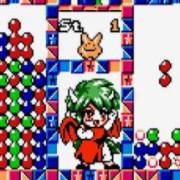

With a lack of solid gaming titles evident at the DS’s launch, Puyo Pop Fever could very well be the best multiplayer game on the system. It is still unclear if this game will even make its way Stateside, but Sega should seriously consider doing so. The DS is perfectly capable of producing 3D characters, but it might not look right in this simple, but addictive puzzle game. And like all the other handheld Puyo Pop’s, Fever will feature the same sprite-based graphics and puzzles that players know and love. Making use of the wireless multiplayer function is the biggest use of the DS’s hardware. However, the standard D-pad will probably appeal to more gamers because it’s what they’re used to.
#PUYO PUYO TETRIS FULL VERSION#
However, the slightly longer load times are of practically no inconvenience since the full version of the game can be played with multiple players.Ĭontrolling the movement of the Puyo can also be done through the touch screen. The only difference between playing a multi-game card game versus a single game card multiplayer game is the load times. Quite a nifty feature.Īlso, up to 8 players can all compete off a single game card. This means that each player can watch the strategy of everyone else. If 8 players are playing at once, four game boards will be squished onto each DS screen. Monitoring your competition could not be easier thanks to the two screens on the DS. Making wonderful use of the wireless function of the DS’s hardware, up to 8 players can compete at once. The Story mode seems a little strange and feels like a quick add-on, but it’s entertaining nonetheless.Īnyone who has played a puzzle game will understand that competing against another human player is way more fun than fighting the computer A.I. Only when Amitie defeats opponents can she become a full-fledged magician. Story mode takes place through the eyes of a young schoolgirl named Amitie. Endless Puyo gives players the chance to best their own scores by fighting for each point in a never-ending game (unless the screen fills). If completed correctly, massive amounts of garbage Puyo will be sent to all other players, almost generating full victory.Īll the standard game types have made their way into Fever.

The player is then presented with a new Puyo puzzle which can be fully cleared with just a few well-placed pieces. Once the fever meter fills to maximum capacity, ‘Fever’ mode ensues. The word ‘Fever’ in the game’s title comes from a frantic new addition to the standard gameplay. Instead of the standard two-blob piece, Fever now incorporates L-shaped pieces, boxes of two-colored pieces, or even boxes of 4×4. It is a wonder why Sega has not yet released this game in the States, considering the translation is already complete.įever separates itself from the other Puyo Pop games by adding a few new gameplay elements. Import gamers should make note, however, that the Japanese version of Puyo Pop Fever can be played entirely in English–voiceovers, texts, and menus are all translated. Unfortunately, the game has not be given a U.S. Puyo Pop Fever for the DS was released before the end of the year in Japan. Just like Tetris, the addictive quality on show here is through the roof. Once the top of the screen is filled with Puyo pieces, the game ends. In order to help defeat opponents, garbage (or blank) Puyo are sent over to the opposing player’s screen after a combo has been made, making it more difficult to clear standard Puyo. Once four of the same colored blobs connect, they disappear. Instead of falling blocks, the Puyo Pop games have players controlling pairs of falling jelly-blobs (called Puyo).

Standing within close proximity of Tetris, Puyo Pop is probably the second best puzzle game for any handheld. Plus, two players could connect two systems together via a link cable and compete in head-to-head battles. Tetris on the original Game Boy revolutionized the puzzle genre by offering a gameplay attitude that was both easy to pick up and play but dangerously hard to master. Puzzle games on handheld videogame systems go together like bread and butter.


 0 kommentar(er)
0 kommentar(er)
